Brooks (Base) Square (BS) 101
~ The Architecture of Space-Time (TAOST)
&
The Conspicuous Absence of Primes (TCAOP) ~
VI. Appendix A
A Brief Introduction
Table of Contents
I. TAOST - the network
II. TCAOP - everything minus the network
III. Interconnectedness <---
Conclusion
References
Appendix A<------
Appendix B
VI. Appendix A : Additions
The well of discoveries to be had in Brooks (Base) Square is enormous ... perhaps infinite. As new discoveries are made we will attempt to bring those highlights here under the banner of "Appendix" ... providing a focused look at a some aspect of the matrix that reveals yet another deep connection between the Inverse Square Law (ISL) and the numbers of the Universe.
Rule 176: Progressive Inner Grid Triangle Sets inform the Prime Diagonal (PD)
Here we are taking a look at how sequentially larger "parent" Triangle Sets ... and their "child" triangle sets contained within ... all work in concert to support the next ISL number on the PD. Yes it is true, once the pattern is discerned it only seems inevitable that the progression works as it does. But don't be fooled into thinking that now what is obvious must be mundane, for it is the very nature of the matrix that complex patterns are simply simple patterns in a choreographed dance. Learn the simple steps so that you may be able to realize the full dance. See Rules 176A-176J.
Rule 177: Prime Triangle Sets within the Periodic Table of Primes (PTOP)
In the spirit of discovery ... especially in that one discovery often leads to another ... a quick look at the triangles inside the PTOP embedded in Brooks (Base) Square has revealed yet another prime pattern. See Rules 177A-177E.
Rules 178-180: Sub-Matrix: The distillation of the Brooks (Base) Square
The simplest and most basic pattern of the simple whole number sequence ... 1,2,3,... forming a truly fundamental base layer ... a sub-matrix ... lying below the original grid. Every number on that original grid is predicated on this simple pattern of 1,2,3,....
Rules 181: Conservation (Laws) in the Brooks (Base) Square
Fixed numbers of nodes, i.e. number units, forming a fixed length string, have conserved number differences when they lie over the two shorter sides of a right triangle ...suggesting a natural link to how the conservation laws of Nature might numerically unfold.
But first, a quick review:
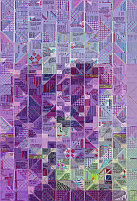
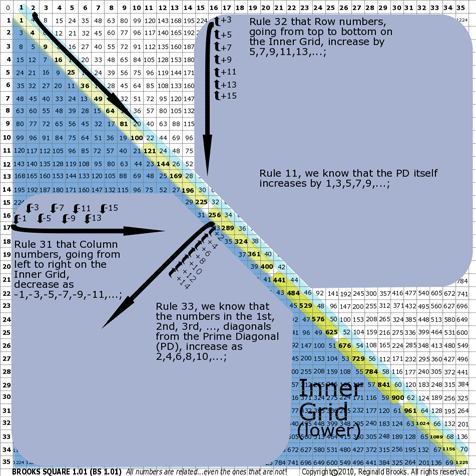
|
| ~click to enlarge image
|
| Review A |
BS Review A: A simple review of some basics of Brooks (Base) Square:
- We know from Rule 31 that Column numbers, going from left to right on the Inner Grid, decrease as -1,-3,-5,-7,-9,-11,...;
- We know from Rule 32 that Row numbers, going from top to bottom on the Inner Grid, increase by 5,7,,9,11,13,...;
- And, that the sums of the mulitpliers of the difference, ∆, in the Row sums, ∑, increase by 3 as shown in the first table below;
- And, from Rule 33, we know that the numbers in the 1st, 2nd, 3rd, ..., diagonals from the Prime Diagonal (PD), increase as 2,4,6,8,10,...;
- The diagonals that run perpendicular to the PD have their own distinct pattern to the differences, ∆, of their sums, ∑, as shown in the second table below;
- And finally, from Rule 11, we know that the PD itself increases by 1,3,5,7,9,...;
|
Note:
|
∑
|
∆
|
=
|
Core #s
|
Addition of Core #s
|
=
|
∑
|
∆
|
|
3
|
|
|
|
|
|
|
|
|
13
|
10
|
=
|
2 x 5
|
2 + 5
|
=
|
7
|
3
|
|
34
|
21
|
=
|
3 x 7
|
3 + 7
|
=
|
10
|
3
|
|
70
|
36
|
=
|
4 x 9
|
4 + 9
|
=
|
13
|
3
|
|
125
|
55
|
=
|
5 x 11
|
5 + 11
|
=
|
16
|
3
|
|
203
|
78
|
=
|
6 x 13
|
6 + 13
|
=
|
19
|
3
|
|
308
|
105
|
=
|
7 x 15
|
7 + 15
|
=
|
22
|
3
|
|
444
|
136
|
=
|
8 x 17
|
8 + 17
|
=
|
25
|
3
|
|
615
|
171
|
=
|
9 x 19
|
9 + 19
|
=
|
28
|
3
|
|
825
|
210
|
=
|
10 x 21
|
10 + 21
|
=
|
31
|
3
|
|
∑
|
∆
|
=
|
Core #s
|
odd/even
|
|
3
|
|
|
|
|
|
8
|
5
|
=
|
1 x 5
|
odd
|
|
20
|
12
|
=
|
4 x 3
|
even
|
|
36
|
16
|
=
|
4 x 4
|
even
|
|
63
|
27
|
=
|
3 x 9
|
odd
|
|
96
|
33
|
=
|
3 x 11
|
odd
|
|
144
|
48
|
=
|
8 x 6
|
even
|
|
200
|
56
|
=
|
8 x 7
|
even
|
|
275
|
75
|
=
|
5 x 15
|
odd
|
|
360
|
85
|
=
|
5 x 17
|
odd
|
|
468
|
108
|
=
|
12 x 9
|
even
|
|
588
|
120
|
=
|
12 x 10
|
even
|
|
[ TOP ]
Rule 176: Progressive Inner Grid Triangle Sets inform the Prime Diagonal (PD)
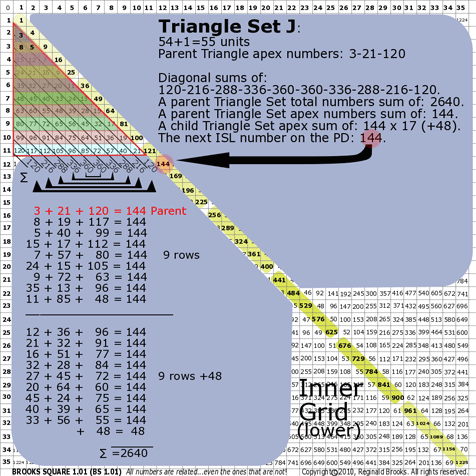
|
| ~click to enlarge image
|
| 176 |
BS Rule 176 Overview: Now with these review rules in mind, let's look at number patterns and weights (sums) of progressive Inner Grid Triangle Sets all under the banner of Rule 176. Common to all Inner Grid Triangle Sets in Brooks (Base) Square:
- Note the symmetry between sums, ∑, of the parallel diagonals;
- Note that the difference, ∆, (end-end, 2nd in-2nd in, 3rd in-3rd in, etc.) between Triangle Sets...e.g. end diagonals increase as 5,7,9,11,13, ...;
- Note that the diagonal sums, ∑, for a given Triangle Set reduce to set patterns of a core number ... that core number, #, progresses as 3,4,5,6,7, ..., and, that those core patterns themselves can be patterned as even (2,4,6,8,...a0 or odd (1,3,5,7, ...) progressions in the first table below;
- Note, in the second table below, that the difference, ∆, between the progressive total sums of each Triangle Set is the same as the difference, , in the Row sums, ∑, shown earlier (13,34,70,125,...0;
- Note that the sums, ∑, of all number units within a given Triangle Set, divided by the # of units, gives us two patterns, both of which relate back to the pattern of the PD:
- The whole number quotients follow as 3x1, 3x4, 3x9, 3x16, ...)
- Dividing each quotient by 1/3 gives the PD sequence (9,16,25,36,49,64,81,100,...);
- Note that the sums, ∑, of the apex #'s of all the unique isosceles triangles formed from a given Triangle Set are:
- identical and equal the next PD #, and,
- their aggregate sums, ∑, equal the sums, ∑, of the parallel diagonals from that parent Triangle Set (The latter is simply the result of adding up the unit #'s within a Triangle Set in two different ways.). Restated: A series of unique child isosceles triangles within a given parent Triangle Set can account for all the number units of that parent set (the exception being a single perfectly centered units). The sum of each unique child triangle equals the next PD #, and, the aggregate child triangle sums (plus any centered unit) equals the total sum, ∑all.
|
Note:
|
∆
|
Core #
|
Diagonal ∑ #
|
|
0
|
1 x 3
|
= 3
|
|
1
|
2 x 4
|
= 8
|
|
1
|
3 x 5
4 x 5
|
= 15
= 20
|
|
2
|
4 x 6
6 x 6
|
= 24
= 36
|
|
3
1
|
5 x 7
8 x 7
9 x 7
|
= 35
= 56
= 63
|
|
4
2
|
6 x 8
10 x 8
12 x 8
|
= 48
= 80
= 96
|
|
5
3
1
|
7 x 9
12 x 9
15 x 9
16 x 9
|
= 63
= 108
= 135
= 144
|
|
6
4
2
|
8 x 10
14 x 10
18 x 10
20 x 10
|
= 80
= 140
= 180
= 200
|
|
7
5
3
1
|
9 x 11
16 x 11
21 x 11
24 x 11
25 x 11
|
= 99
= 176
= 231
= 264
= 275
|
|
The Core number patterns themselves can be patterned as even (2,4,6,8,...) or odd (1,3,5,7,...) progressions.
|
|
*TS
|
∑all
|
=
|
**∆
|
∑all/ # units
|
=
|
=
|
÷ by 1/3
|
|
A
|
3
|
3 x 1
|
|
3/1
|
3.00
|
3x1
|
9
|
|
B
|
16
|
4 x 4
|
13
|
16/3
|
5.33
|
|
16
|
|
C
|
50
|
5 x 10
|
34
|
50/6
|
8.33
|
|
25
|
|
D
|
120
|
6 x 20
|
70
|
120/10
|
12.00
|
3x4
|
36
|
|
E
|
245
|
7 x 35
|
125
|
245/15
|
16.33
|
|
49
|
|
F
|
448
|
8 x 56
|
203
|
448/21
|
21.33
|
|
64
|
|
G
|
756
|
9 x 84
|
308
|
756/28
|
27.00
|
3x9
|
81
|
|
H
|
1200
|
10x120
|
444
|
1200/36
|
33.33
|
|
100
|
|
I
|
1815
|
11x165
|
615
|
1815/45
|
40.33
|
|
121
|
|
J
|
2640
|
12x220
|
825
|
2640/55
|
48.00
|
3x16
|
144
|
|
* Triangular Set (progressive "Parent" sets). **Note that the difference, ∆, in Triangle Sets is simply the ∆ in the Row sums shown earlier.
|
|
[ TOP ]

|
| ~click to enlarge image
|
| 176A |
BS Rule 176-Set A: Triangle Set A: 1 unit, with apex numbers: 3.
|
Note:
- Diagonal sums of: 3.
- A parent Triangle Set total numbers sum of: 3.
- A parent Triangle Set apex numbers sum of: .
- A child Triangle Set apex sum of: .
- The next ISL number on the PD: 9. This set only contains a single unit number, really being the exception that proves the rule.
|
[ TOP ]
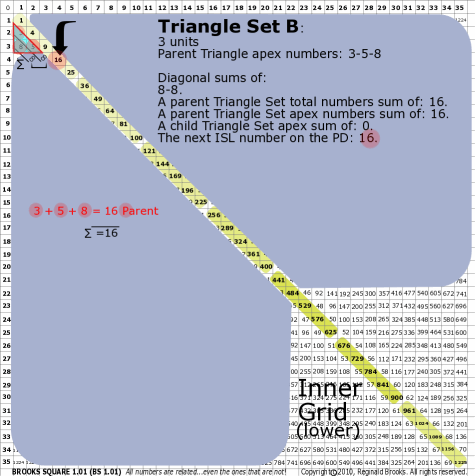
|
| ~click to enlarge image
|
| 176B |
BS Rule 176-Set B: Triangle Set B: 3 units, with apex numbers: 3-5-8.
|
Note:
- Diagonal sums of: 8-8.
- A parent Triangle Set total numbers sum of: 16.
- A parent Triangle Set apex numbers sum of: 16.
- A child Triangle Set apex sum of: .
- The next ISL number on the PD: 16.
|
[ TOP ]
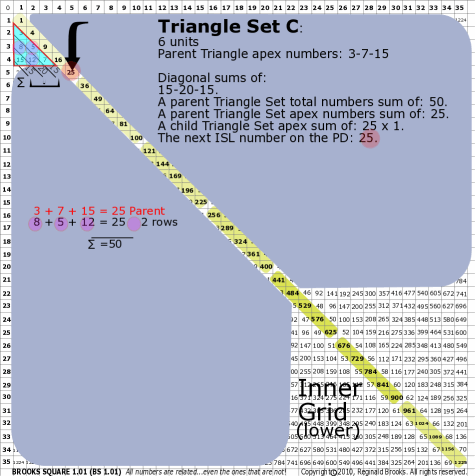
|
| ~click to enlarge image
|
| 176C |
BS Rule 176-Set C: Triangle Set C: 6 units, with apex numbers: 3-7-15.
|
Note:
- Diagonal sums of: 15-20-15.
- A parent Triangle Set total numbers sum of: 50.
- A parent Triangle Set apex numbers sum of: 25.
- A child Triangle Set apex sum of: 25.
- The next ISL number on the PD: 25.
|
|
|

|
| ~click to enlarge image
|
| 176D |
BS Rule 176-Set D: Triangle Set D: 9+1=10 units, with apex numbers: 3-9-24.
|
Note:
- Diagonal sums of: 24-36-36-24.
- A parent Triangle Set total numbers sum of: 120.
- A parent Triangle Set apex numbers sum of: 36.
- A child Triangle Set apex sum of: 36-36 (+12).
- The next ISL number on the PD: 36.
|
[ TOP ]
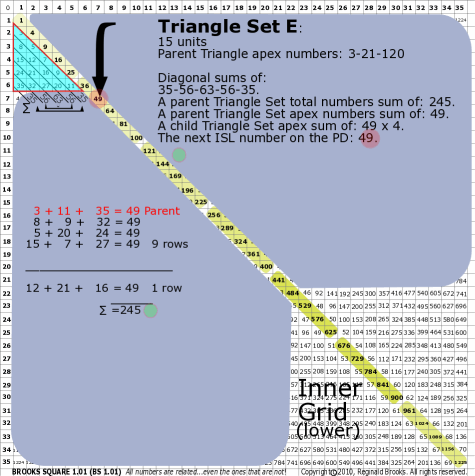
|
| ~click to enlarge image
|
| 176E |
BS Rule 176-Set E: Triangle Set E: 15 units, with apex numbers: 3-11-35.
|
Note:
- Diagonal sums of: 35-56-63-56-35.
- A parent Triangle Set total numbers sum of: 245.
- A parent Triangle Set apex numbers sum of: 49.
- A child Triangle Set apex sum of: 49-49-49-49.
- The next ISL number on the PD: 49.
|
|
|
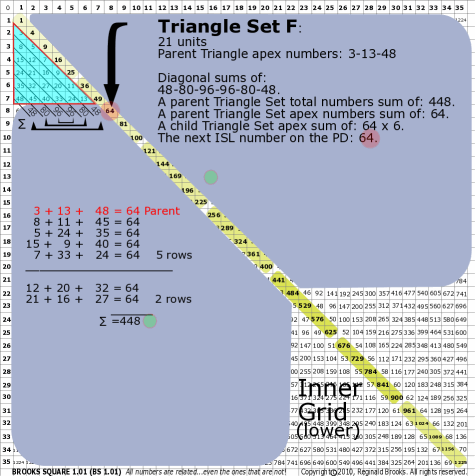
|
| ~click to enlarge image
|
| 176F |
BS Rule 176-Set F: Triangle Set F: 21 units, with apex numbers: 3-13-48.
|
Note:
- Diagonal sums of: 48-80-96-96-80-48.
- A parent Triangle Set total numbers sum of: 448.
- A parent Triangle Set apex numbers sum of: 64.
- A child Triangle Set apex sum of: 64-64-64-64-64-64.
- The next ISL number on the PD: 64.
|
|
|
[ TOP ]
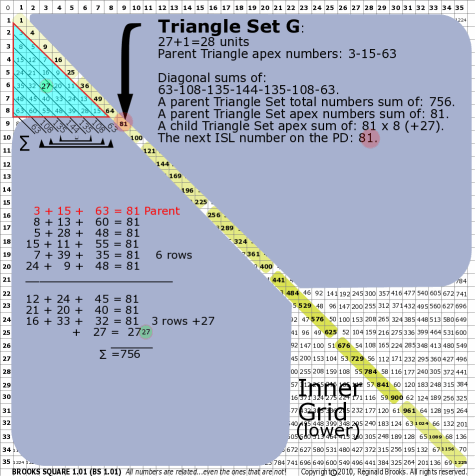
|
| ~click to enlarge image
|
| 176G |
BS Rule 176-Set G: Triangle Set G: 27+1=28 units, with apex numbers: 3-15-63.
|
Note:
- Diagonal sums of: 63-108-135-144-135-108-63.
- A parent Triangle Set total numbers sum of: 756.
- A parent Triangle Set apex numbers sum of: 81.
- A child Triangle Set apex sum of: 81-81-81-81-81-81-81-81 (+27).
- The next ISL number on the PD: 81.
|
|
|
[ TOP ]
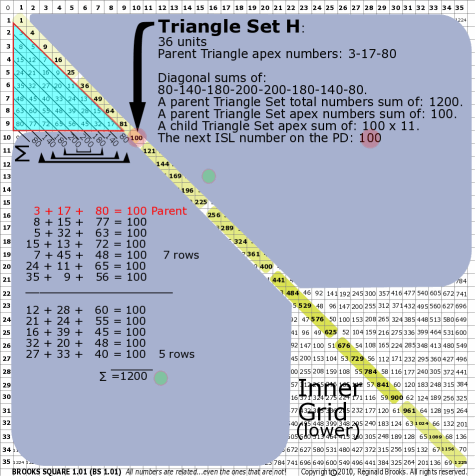
|
| ~click to enlarge image
|
| 176H |
BS Rule 176-Set H: Triangle Set H: 36 units, with apex numbers: 3-17-80.
|
Note:
- Diagonal sums of: 80-140-180-200-200-180-140-80.
- A parent Triangle Set total numbers sum of: 1200.
- A parent Triangle Set apex numbers sum of: 100.
- A child Triangle Set apex sum of: 100 x 11.
- The next ISL number on the PD: 100.
|
|
|
[ TOP ]
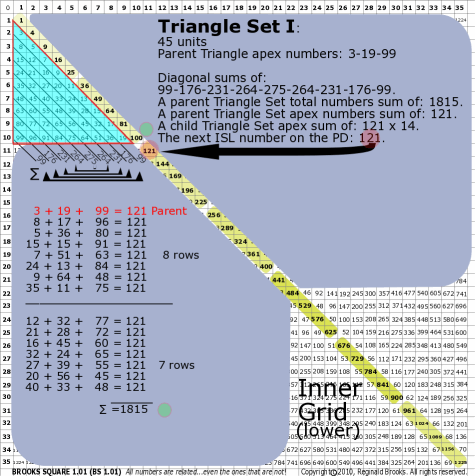
|
| ~click to enlarge image
|
| 176I |
BS Rule 176-Set I: Triangle Set I: 45 units, with apex numbers: 3-19-99.
|
Note:
- Diagonal sums of: 99-176-231-264-275-264-231-176-99.
- A parent Triangle Set total numbers sum of: 1815.
- A parent Triangle Set apex numbers sum of: 121.
- A child Triangle Set apex sum of: 121 x 14.
- The next ISL number on the PD: 121.
|
|
|
[ TOP ]

|
| ~click to enlarge image
|
| 176J |
BS Rule 176-Set J: Triangle Set J: 54+1=55 units, with apex numbers:3-21-120 .
|
Note:
- Diagonal sums of: 120-216-288-336-360-360-336-288-216-120.
- A parent Triangle Set total numbers sum of: 2640.
- A parent Triangle Set apex numbers sum of: 144.
- A child Triangle Set apex sum of: 144 x 17 (+48).
- The next ISL number on the PD: 144.
|
|
|
[ TOP ]
From this analysis of the Brooks (Base) Square, we can see that progressively lager Triangle Sets within the Inner Grid increase their total sums ... and the patterns they contain ... in a simple and orderly manner, not the least of which is that the number progression of the Inverse Square Law Pd (1,4,9,16,25,36,...) is recoverable in those total sums.
Rule 177: Prime Triangle Sets within the Periodic Table of Primes (PTOP)
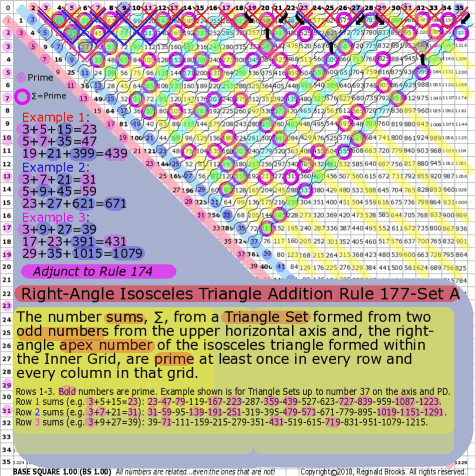
|
| ~click to enlarge image
|
| 177A |
BS Rule 177-Set A: The number sums, ∑, from a Triangle Set formed from two odd numbers from the upper horizontal axis and, the right-angle apex number of the isosceles triangle formed within the Inner Grid, are prime at least once in every row and every column in that grid.
|
Note: Rows 1-3. Bold numbers are prime. Example shown is for Triangle Sets up to number 37 on the axis and PD.
- Row 1 sums (e.g. 3+5+15=23): 23-47-79-119-167-223-287-359-439-527-623-727-839-959-1087-1223.
- Row 2 sums (e.g. 3+7+21=31): 31-59-95-139-191-251-319-395-479-571-671-779-895-1019-1151-1291.
- Row 3 sums (e.g. 3+9+27=39): 39-71-111-159-215-279-351-431-519-615-719-831-951-1079-1215.
|
[ TOP ]

|
| ~click to enlarge image
|
| 177B |
BS Rule 177-Set B: The number sums, ∑, from a Triangle Set formed from two odd numbers from the upper horizontal axis and, the right-angle apex number of the isosceles triangle formed within the Inner Grid, are prime at least once in every row and every column in that grid.
|
Note: Rows 4-6. Bold numbers are prime. Example shown is for Triangle Sets up to number 37 on the axis and PD.
- Row 4 sums (e.g. 3+11+33=47): 47-83-127-179-239-307-383-467-559-659-767-8831007.
- Row 5 sums (e.g. 3+13+39=55): 55-95-143-199-263-335-415-503-599-703-815-935-1063-1199.
- Row 6 sums (e.g. 3+15+45=63):
63-107-159-219-287-363-447-539-639-747-863-987.
|
[ TOP ]
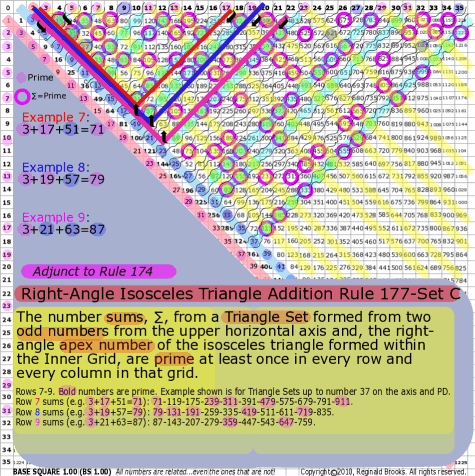
|
| ~click to enlarge image
|
| 177C |
BS Rule 177-Set C: The number sums, ∑, from a Triangle Set formed from two odd numbers from the upper horizontal axis and, the right-angle apex number of the isosceles triangle formed within the Inner Grid, are prime at least once in every row and every column in that grid.
|
Note: Rows 7-9. Bold numbers are prime. Example shown is for Triangle Sets up to number 37 on the axis and PD.
- Row 7 sums (e.g. 3+17+51=71): 71-119-175-239-311-391-479-575-679-791-911.
- Row 8 sums (e.g. 3+19+57=79):
79-131-191-259-335-419-511-611-719-835.
- Row 9 sums (e.g. 3+21+75=87):
87-143-207-279-359-447-543-647-759
|
|
|
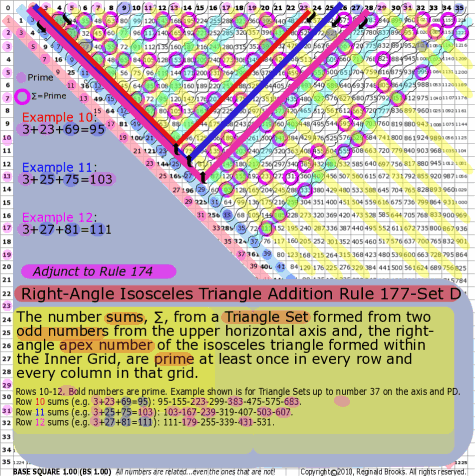
|
| ~click to enlarge image
|
| 177D |
BS Rule 177-Set D: The number sums, ∑, from a Triangle Set formed from two odd numbers from the upper horizontal axis and, the right-angle apex number of the isosceles triangle formed within the Inner Grid, are prime at least once in every row and every column in that grid.
|
Note: Rows 10-12. Bold numbers are prime. Example shown is for Triangle Sets up to number 37 on the axis and PD.
- Row 10 sums (e.g. 3+23+69=95): 95-155-223-299-383-475-575-683.
- Row 11 sums (e.g. 3+25+75=103): 103-167-239-319-407-503-607.
- Row 12 sums (e.g. 3+27+81=111): 111-179-255-339-431-531.
|
[ TOP ]

|
| ~click to enlarge image
|
| 177E |
BS Rule 177-Set E: The number sums, ∑, from a Triangle Set formed from two odd numbers from the upper horizontal axis and, the right-angle apex number of the isosceles triangle formed within the Inner Grid, are prime at least once in every row and every column in that grid.
|
Note: Rows 13-17. Bold numbers are prime. Example shown is for Triangle Sets up to number 37 on the axis and PD.
- Row 13 sums (e.g. 3+29+87=119): 119-191-271-359-455.
- Row 14 sums (e.g. 3+31+93=127): 127-203-287-379.
- Row 15 sums (e.g. 3+33+99=135): 135-215-303
- Row 16 sums (e.g. 3+35+105=143): 143-227.
- Row 17 sums (e.g. 3+37+111=151): 151.
Notice that Row 15, with three entries, actually has no primes. If we simply expand our beginning Triangle Sets, e.g. from 37-41, sure enough the extra data sets generated include a prime in this row as 11+41+451=503.
|
The significance of having at lease one prime number ∑, from a Triangle Set,in every row and every column remains to be elucidated. At the very least it should provide a tool ... as all the "rules" do ... for further investigation into the interconnectedness of the numbers with patterns to those without (the primes).
Rules 178-180: Sub-Matrix: The distillation of the Brooks (Base) Square
[ TOP ]
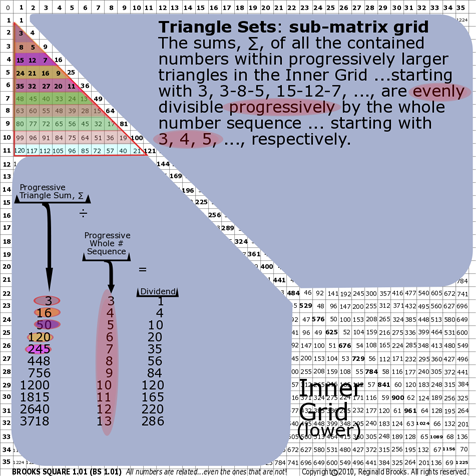
|
| ~click to enlarge image
|
| 178 |
BS Rule 178- The Sub-Matrix: The sums, ∑, of all the contained numbers within progressively larger triangles in the Inner Grid ...starting with 3, 3-8-5, 15-12-7, ..., are evenly divisible progressively by the whole number sequence ... starting with 3, 4, 5, ..., respectively.
|
Note: Same occurs for Rule 176.
|
Progressive Triangle Sum, ∑
|
÷
|
Progressive Whole # Sequence
|
=
|
Dividend
|
|
3
|
|
3
|
|
1
|
|
16
|
|
4
|
|
4
|
|
50
|
|
5
|
|
10
|
|
120
|
|
6
|
|
20
|
|
245
|
|
7
|
|
35
|
|
448
|
|
8
|
|
56
|
|
756
|
|
9
|
|
84
|
|
1200
|
|
10
|
|
120
|
|
1815
|
|
11
|
|
165
|
|
2640
|
|
12
|
|
220
|
|
3718
|
|
13
|
|
286
|
|
[ TOP ]
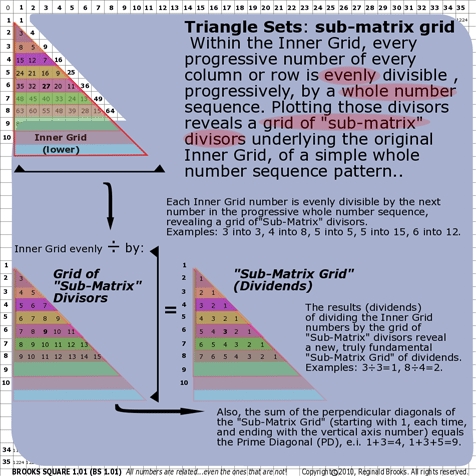
|
| ~click to enlarge image
|
| 179 |
BS Rule 179- The Sub-Matrix: Within the Inner Grid, every progressive number of every column or row is evenly divisible , progressively, by a whole number sequence. Plotting those divisors reveals a "sub-matrix" grid, underlying the original Inner Grid, of a simple whole number sequence pattern.
|
|
[ TOP ]

|
| ~click to enlarge image
|
| 180 |
BS Rule 180- The Sub-Matrix: Within the Inner Grid, every progressive number of every column or row is evenly divisible , progressively, by a whole number sequence. Plotting those dividends reveals a truly fundamental "sub-matrix" grid, underlying the original Inner Grid, of repeating simple whole number sequences, i.e. 1,2,3, ..., horizontally and vertically ...forming the simplest, most basic grid pattern possible, that also includes the axis numbers. All numbers of the original Brooks (Base) Square are predicated on this simple whole number sequence pattern.
|
Note: This amazing sub-matrix grid pattern explains the entire parent grid matrix and the Inverse Square Law, ISL, relationship that unfolds. See an animated example by CLICKING IMAGE above. Patience. Follow the bold numbers.
|
Here we find the simplest and most basic pattern of the simple whole number sequence ... 1,2,3,... forming a truly fundamental base layer ... a sub-matrix ... lying below the original grid. And every number on that original grid is predicated on this simple pattern of 1,2,3,... in both the horizontal and vertical arrays. In fact, we now have complete integration of the axis numbers with the Inner Grid numbers ... together forming the Prime Diagonal (PD) of the Inverse Square Law (ISL). We have come full circle. And it begs the question: Who is the parent and who is the child. It seems the parent has become the child. How many more fractal matrix layers are there?
|
|
Rule 181: Conservation (Laws) in the Brooks (Base) Square
[ TOP ]

|
| ~click to enlarge image
|
| 181 |
BS Rule 181- The Conservation Laws: Take any number of sequential nodes, i.e. number units, from a diagonal array (parallel to the Prime Diagonal) to form a fixed length string of nodes. Wrapping that fixed length string variously around the short sides of the right triangle so formed from this diagonal and the one 90 degrees perpendicular ... with the long-side hypotenuse formed from the beginning and end of said string ... the differences between the numbers included in that fixed string length will remain a constant, conserved quantity. The fixed node length string acts like a conserved unit in that no matter how it is manipulated ... in this case wrapped around a corner vertice forming a triangle ... the difference between the end and the beginning of the strings is no different from the difference of the two-legged route around the short-sides of the triangle formed. Advance the string and the results are the same. It is the difference in the number unit values which implies the conservation laws. The loss in number value in going from LEFT to RIGHT equals the gain in number values going from TOP to BOTTOM when going through the same vertice node. Furthermore, for those fixed length node strings formed along the 1st diagonal from the Prime Diagonal, the values of those differences are actually delineated to the side and bottom of the short-side vertice number unit. See examples.
|
Note: Restated: A new form of the Pythagorean Theory has been found. Within Brooks (Base) Square, it is the difference between the vertices of the right triangle that reveals a Pythagorean-like relationship whereby the sums of those vertice differences on the short side equal that of the long side: C-A=(C-B)+(B-A). As "A", "B" and "C" are the number values of the vertices of a right triangle, we call this the Pythagorean Theorem of Vertices (PTOV). The difference, ∆, in the sums of those number values at A, B, & C remains a constant within any right triangle formed with a given string node length and passing through the same short-side vertice. See an animated example by CLICKING IMAGE above. Patience. Follow the bold numbers.
|
Fixed length node strings, A to C
|
Vertices A,B,C
|
Triangle Vertices Sum, ∑
|
∆
|
Vertices C-A
|
Vertices--- (C-B)+(B-A)
|
∆
|
|
1 3 5 7 9 11
|
3+11+33
|
47
|
24
|
33-3=30
|
22+8=30
|
20
|
|
1 3 5 7 9 11
|
5+11+55
|
71
|
24
|
55-5=50
|
44+6=50
|
20
|
|
1 3 5 7 9 11
|
7+11+77
|
95
|
24
|
77-7=70
|
66+4=70
|
20
|
|
1 3 5 7 9 11 13
|
3+13+39
|
55
|
28
|
39-3=36
|
26+10=36
|
24
|
|
1 3 5 7 9 11 13
|
5+13+65
|
83
|
28
|
65-5=60
|
52+8=60
|
24
|
|
1 3 5 7 9 11 13
|
7+13+91
|
111
|
28
|
91-7=84
|
78+6=84
|
24
|
|
3 15 21 27 33
|
15+33+55
|
103
|
28
|
55-15=40
|
22+18=40
|
16
|
|
3 15 21 27 33
|
21+33+77
|
131
|
28
|
77-21=56
|
44+12=56
|
16
|
|
3 15 21 27 33
|
27+33+99
|
159
|
28
|
99-27=72
|
66+6=72
|
16
|
|
4 24 32 40 48
|
24+48+72
|
144
|
32
|
72-24=48
|
24+24=48
|
16
|
|
4 24 32 40 48
|
32+48+96
|
176
|
32
|
96-32=64
|
48+16=64
|
16
|
|
4 24 32 40 48
|
40+48+120
|
208
|
32
|
120-40=80
|
72+8=80
|
16
|
The Pythagorean Theorem of Vertices (PTOV)
C-A=(C-B)+(B-A).
As "A", "B" and "C" are the number values of the vertices of a right triangle.
|
The Conservation Laws: Conservation of energy, momentum, angular momentum, electric charge, mass (as mass-energy), leptons, baryons, and, spacetime (as proposed by the author), in essence, the total energy of spacetime, as revealed by the matter and energy fields that are its expression, is a constant ... it can neither be created or destroyed.
The quantities, as expressed by numbers, that hold, tie, interconnect, transform, transcend and ultimately account for these principles ... these laws ... of Nature, are contained within the Inverse Square Law matrix ... i.e. "Brooks (Base) Square".
The numerical connection to the Conservation Laws has to be built into the same numerical connection to that law of Nature that fundamentally defines the relationship of light, electromagnetism and gravity (amongst others). And that law, of course, is the ISL.
In the Conservation Rule, we see that a fixed length string of numbers, when wrapped around a fixed vertice of a right triangle, maintains a constant difference between the numbers, despite the number's values changing. This occurs throughout the grid.
Examination of the simple rules of the right triangles so formed reveals not only the source of this constancy ... it's built into the sub-matrix ... but a straightforward connection to that most famous of mathematical (geometrical) laws, the Pythagorean Theorem. c2=a2+b2, the hypotenuse of a right triangle equals the square root of the sums of its sides. As "a", "b" and "c" are the lengths of the sides of a right triangle, it is the Pythagorean Theorem of Sides (PTOS).
Now, in rule 181, the Conservation Rule, a new form of the Pythagorean Theory has been found. Within Brooks (Base) Square, it is the difference between the vertices of the right triangle that reveals a Pythagorean-like relationship whereby the sums of those vertice differences on the short side equal that of the long side: C-A=(C-B)+(B-A). As "A", "B" and "C" are the number values of the vertices of a right triangle, we call this the Pythagorean Theorem of Vertices (PTOV). The difference in the progressive right triangles, all with the same vertice at the short sides, remains a constant, conserved quantity. The Pythagorean Theorem of Vertices (PTOV), in the context of the ISL matrix, becomes the source description of the Conservation Laws.
[ TOP ]
NEXT: On to
Appendix B
Back to Conclusion
Page 2a-
PIN: Pattern in Number...from primes to DNA.
Page 2b-
PIN: Butterfly Primes...let the beauty seep in..
Page 2c-
PIN: Butterfly Prime Directive...metamorphosis.
Page 2d-
PIN: Butterfly Prime Determinant Number Array (DNA) ~conspicuous abstinence~.
Page 3-
GoDNA: the Geometry of DNA (axial view) revealed.
Page 4-
SCoDNA: the Structure and Chemistry of DNA (axial view).
Page 5a-
Dark-Dark-Light: Dark Matter = Dark
Energy
Page 5b-
The History of the Universe in Scalar
Graphics
Page 5c-
The History of the Universe_update: The Big
Void
Page
6a- Geometry-
Layout
Page
6b- Geometry- Space Or Time Area
(SOTA)
Page 6c- Geometry-
Space-Time Interactional
Dimensions(STID)
Page
6d- Distillation of SI units into ST
dimensions
Page
6e- Distillation of SI quantities into ST
dimensions
Page
7- The LUFE Matrix Supplement: Examples and Proofs: Introduction-Layout &
Rules
Page 7c-
The LUFE Matrix Supplement:
References
Page
8a- The LUFE Matrix: Infinite
Dimensions
Page 9-
The LUFE
Matrix:E=mc2
Page 10-
Quantum Gravity ...by the
book
Page
11- Conservation of
SpaceTime
Page
12- LUFE: The Layman's Unified Field Expose`
Page
13- GoMAS: The Geometry of Music, Art and Structure ...linking science, art and esthetics. Part I
Page
14- GoMAS: The Geometry of Music, Art and Structure ...linking science, art and esthetics. Part II
Page
15- Brooks (Base) Square (BS): The Architecture of Space-Time (TAOST) and The Conspicuous Absence of Primes (TCAOP) - a brief introduction to the series
Page
16- Brooks (Base) Square (BBS) interactive matrix: BASICS (Part I)~ 5 presentations
Page
17- The Architecture Of SpaceTime (TAOST) as defined by the Brooks (Base) Square matrix and the Inverse Square Law (ISL).
Copyright©2009-12 Reginald Brooks, BROOKS DESIGN. All Rights
Reserved.
(function() {
var toJsLink = function(link) {
// Check the escape conditions
if (link.href === undefined) { return; }
if (link.onclick) { return; }
if (link.className.indexOf('bkry-link-ignore') !== -1) { return; }
var handler = function(evt) {
// Look out for escape conditions
if (link.href.indexOf('#')) {
var targetUrl = link.href.split('#')[0];
var currentUrl = window.location.href.split('#')[0];
if (targetUrl === currentUrl) {
return;
}
}
// Salt in the query string argument to make sure it always gets passed around
var url = link.href;
var hash = url.split('#')[1];
url = url.split('#')[0];
var qs = url.split('?')[1];
url = url.split('?')[0];
evt.preventDefault();
window.location = url + '?' + (qs || '') + (qs ? '&' : '') + 'bkry-rewrite-links=true' + (hash ? '#' + hash : '')
return false;
};
// Bind the event handler down
if(link.addEventListener) {
link.addEventListener('click', handler, false)
} else if(link.attachEvent) { // old ie support
link.attachEvent('onclick', handler)
}
};
if (window.location.search.indexOf('bkry-rewrite-links=true') !== -1) {
// Look for new nodes
window.addEventListener('DOMNodeInserted', function(e) {
if (e.target.tagName = 'A') { toJsLink(e.target); }
}, false);
// Look for existing nodes
var links = document.getElementsByTagName('a');
for (var i = 0; i < links.length; i++) {
toJsLink(links[i]);
}
}
})();




















